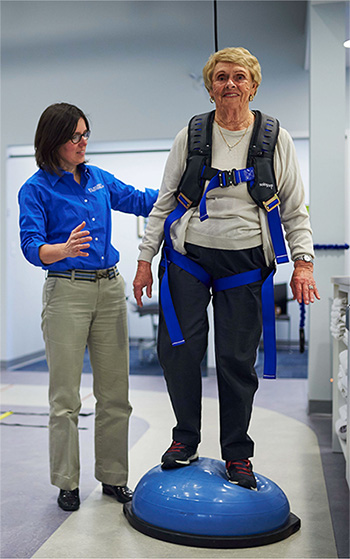Vestibular Rehabilitation
How does the vestibular system work?
The vestibular system is a main contributor to physical balance. Located in the inner ear, the system senses motion when small hairs, called cilia, are moved by microscopic calcium crystals. When we sit, stand, move, or experience motions (such as in a car) the crystals move the hairs. The brain receives the signals from the hairs, along with information from the eyes and your sense of touch to interpret motion, equilibrium, and orientation in space.
In order to understand how Vestibular Rehabilitation works and the underlying corrective mechanisms, it is important to remember that the primary role of the vestibular system is to tell the brain where the head is in space. Quite simply, the vestibular system is our internal reference telling the brain how our head is orientated - up, down, tilt, etc. The visual and somatosensory (touch, pressure, pain) systems, on the other hand, are external references, providing our brain with information about the movement and stability of the world around us. Working together and when the systems agree, it is the integration of these sensory modalities that provides us with normal equilibrium.

How vestibular rehabilitation can help you?
Vestibular Rehabilitation is a form of Balance Retraining Therapy. It has emerged over the past several years as an alternative treatment for patients with chronic non-resolved motion intolerance, visual sensitivity, and imbalance problems. At FYZICAL, we have a comprehensive balance program that includes assessment and evaluation programs, balance retraining, and vestibular rehabilitation. With balance retraining and vestibular rehabilitation, our goal is to improve balance function and visual motor control, increase general activity levels, and help your body compensate for inner ear disorders. We utilize a state-of-the-art balance machine and our balance therapy programs have a 99% balance improvement success rate.
What Do The Statistics Say?
Falls are the leading cause of fatal and non-fatal injuries for older Americans. Falls threaten a senior’s safety and independence, and generate enormous economic and personal costs.
- Falls among adults 65 and older caused over 34,000 deaths in 2019, making it the leading cause of injury death for that age group
- In 2019, emergency departments recorded 3 millions falls from older adults
- 1 out of 5 falls results in a serious injury such as broken bones or a head injury
- Every 19 minutes, a senior dies due to an unintentional fall
Prevention is Key!
“Use it or Lose it”
Our balance gets worse as we age, mainly because we quit challenging it. One of the most common questions our patietns as is: "Am I too old to have good balance?" NO! The balance system is like a muscle, you can train it to improve your stability and endurance.
Falls are NOT an inevitable result of aging. The number of falls among seniors can be reduced by:
–Evidence-based interventions
–Practical lifestyle adjustments
–Clinic - community partnerships
Who could Benefit
